Does Yarmouth Runic Stone Describe A Trans-Atlantic Viking Voyage?
Ellen Lloyd - AncientPages.com - In 1812, a Yarmouth doctor, Richard Fletcher stumbled upon a mysterious 400-pound boulder in a salt marsh in the Nova Scotia area, in Canada. The mysterious stone is covered with an inscription consisting of only fourteen characters, but the question remains - who wrote it?
Can the Yarmouth Runic Stone offer evidence Vikings made a Trans-Atlantic journey? Credit: Adobe Stock - Nejron Photo
This particular inscription has puzzled researchers for decades and some believe the characters are Norse runes. Thousands of Norse inscriptions made in stone, wood, and metal have been unearthed, and each item gives us a glimpse into a culture that believed in the power and protection of the gods, telling fortunes and casting spells, and the glory of war.
Readers of Ancient Pages will know that runes, God Odin's secret language played an important role in the lives of the Vikings.
'Calling of Vikings,' by Viktor Vasnetsov Viktor Vasnetsov (1848-1926) - Credit: WikiPaintings - Public Domain
Whether the inscription on the Yarmouth stone, also known as the Fletcher Stone is genuine or not has never been determined. Some think it is nothing but a hoax, while others say it’s just a work of Mother Nature. However, there are also other interpretations that could shed more light on this puzzling inscription.
The Yarmouth Runic Stone is very interesting in the history of Yarmouth. Most people think that it was left by the Vikings — that’s the general theory — but there are lots of other theories. Basically, it was found towards the end of Yarmouth harbor in 1812 by Doctor Fletcher. Some people, notably the descendants of Dr. Fletcher, always felt that he did the carving because he was apparently a practical joker: and his family always felt that he did it. Lots of others have felt that the Vikings left the stone, and it’s been translated a couple of times by various people from the Runes.
One translation was made by Henry Phillips Junior around about 1875, and he felt that the Runes read either ‘Hako spoke to his men’ or ‘Hako’s son spoke to his men,” said Curator, Eric J. Ruff of the Yarmouth County Museum where the stone is preserved and displayed.
The Yarmouth Runic Stone as currently displayed at the Yarmouth County Museum. Credit: Public Domain
Dr. Barry Fell suggested that the Yarmouth inscription could be written in early Basque, reading "Basque people have subdued this land". His theory was based on the possibility that such stones were deliberately set up along the coast to inform other travelers that territory had already been claimed.
Another possibility, as proposed by Elbert E. Esmiol is that we are seeing a precious artifact left by visitors from the Mycenaean civilization, one of the greatest civilizations of Greek prehistory famous for its majestic architecture and imposing monuments.
The Mycenaean civilization which, according to legend, had been ruled by King Agamemnon, the conqueror of Troy, sprang to life suddenly in southern and central Greece in about 1600 BC.
Closeup of the apparent inscription. Credit: Wreck Smurfy/Public Domain
Developing from seemingly nothing, this civilization would grow to prominence and become one of the most dominant civilizations of the Aegean for hundreds of years.
Esmiol proposed that the inscription is in one of the royal Mycenaean alphabets, and reads as follows:
"Exalted Throne: The pure Lions of the royal household sent into the sunset to protect, to seize, and to make a hole in the mighty waters at the summit have been sacrificed - the whole corporate body".
Yet another theory, proposed by John Campbell is that the inscription is in Old Japanese and reads "wabi deka Kuturade bushi goku" - "Katurade, the eminent warrior, has died in peace". According to the Yarmouth County Museum, the Yarmouth stone is real, but the origin of the inscription remains unknown.
Updated on June 23, 2021
Written by - Ellen Lloyd – AncientPages.com
Copyright © AncientPages.com All rights reserved. This material may not be published, broadcast, rewritten or redistributed in whole or part without the express written permission of AncientPages.com
Expand for referencesMore From Ancient Pages
-
 Oldest Known Evidence Of Artificial Cranial Deformation Revealed In Croatia
Archaeology | Aug 26, 2019
Oldest Known Evidence Of Artificial Cranial Deformation Revealed In Croatia
Archaeology | Aug 26, 2019 -
 We Dated A Sacred Aboriginal Women’s Site Used for Birthing Ceremonies And Discovered 7,000 Years Of Tool Making
Featured Stories | Jun 21, 2024
We Dated A Sacred Aboriginal Women’s Site Used for Birthing Ceremonies And Discovered 7,000 Years Of Tool Making
Featured Stories | Jun 21, 2024 -
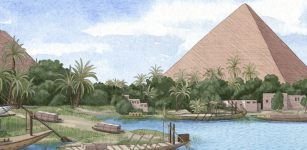 Evidence The Khufu Channel Aided The Construction Of The Giza Pyramids Found – Scientists Say
Archaeology | Aug 31, 2022
Evidence The Khufu Channel Aided The Construction Of The Giza Pyramids Found – Scientists Say
Archaeology | Aug 31, 2022 -
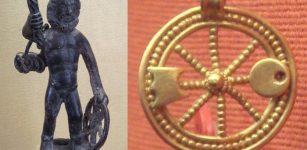 Taranis – Celtic God Of Wheel And Thunder Resembled Roman God Jupiter
Celtic Mythology | Jul 15, 2019
Taranis – Celtic God Of Wheel And Thunder Resembled Roman God Jupiter
Celtic Mythology | Jul 15, 2019 -
 3,000-Year-Old Bakery With Large Amounts Of Flour Discovered In Armenia
Archaeology | Jul 3, 2023
3,000-Year-Old Bakery With Large Amounts Of Flour Discovered In Armenia
Archaeology | Jul 3, 2023 -
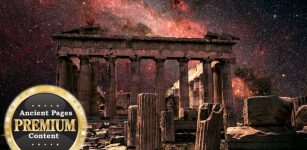 Is ‘Someone’ Regularly Altering The Course Of History? – Unexplained Events – Part 2
Ancient Mysteries | Dec 3, 2020
Is ‘Someone’ Regularly Altering The Course Of History? – Unexplained Events – Part 2
Ancient Mysteries | Dec 3, 2020 -
 Rök Stone (Rök Runestone): Longest Runic Inscription Ever Discovered
Featured Stories | Jun 12, 2024
Rök Stone (Rök Runestone): Longest Runic Inscription Ever Discovered
Featured Stories | Jun 12, 2024 -
 Oldest case of leukemia found on 7,000-Year-old skeleton
News | Aug 23, 2015
Oldest case of leukemia found on 7,000-Year-old skeleton
News | Aug 23, 2015 -
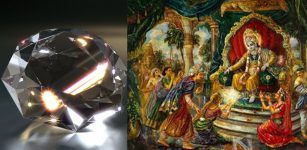 Syamantaka – Divine Jewel With Magical Powers Was A Gift From The Sun God In Hindu Mythology
Featured Stories | Mar 1, 2019
Syamantaka – Divine Jewel With Magical Powers Was A Gift From The Sun God In Hindu Mythology
Featured Stories | Mar 1, 2019 -
 Major Underwater Archaeological Find On The Western Coast Of Sicily – Artifacts From The Battle Of The Egadi Islands?
Archaeology | Sep 11, 2023
Major Underwater Archaeological Find On The Western Coast Of Sicily – Artifacts From The Battle Of The Egadi Islands?
Archaeology | Sep 11, 2023 -
 On This Day In History: Sweden’s Greatest Defeat: Battle Of Kirchholm Was Fought – On Sep 27, 1605
News | Sep 27, 2016
On This Day In History: Sweden’s Greatest Defeat: Battle Of Kirchholm Was Fought – On Sep 27, 1605
News | Sep 27, 2016 -
 Shaka Zulu: African Hero And One Of Greatest Military Leaders Of All Time
Featured Stories | Nov 5, 2016
Shaka Zulu: African Hero And One Of Greatest Military Leaders Of All Time
Featured Stories | Nov 5, 2016 -
 Magnificent And Massive Great Wall Of India – Astonishing Ancient Structure Shrouded In Secrecy
Civilizations | Jul 7, 2015
Magnificent And Massive Great Wall Of India – Astonishing Ancient Structure Shrouded In Secrecy
Civilizations | Jul 7, 2015 -
 DNA Study Of Controversial Ancient North American Mummies, Including The Spirit Cave Mummy Opens An Extraordinary Chapter In Human History
Archaeology | Nov 15, 2018
DNA Study Of Controversial Ancient North American Mummies, Including The Spirit Cave Mummy Opens An Extraordinary Chapter In Human History
Archaeology | Nov 15, 2018 -
 Pregnant Woman’s Remains With An 8-Month Fetus Unearthed At Ancient Taosibei Cemetery, Shanxi, China
Archaeology | Jun 13, 2022
Pregnant Woman’s Remains With An 8-Month Fetus Unearthed At Ancient Taosibei Cemetery, Shanxi, China
Archaeology | Jun 13, 2022 -
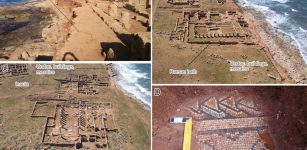 Archaeological Sites At Risk From Coastal Erosion On The Cyrenaican Coast Of Libya
Archaeology | Apr 15, 2023
Archaeological Sites At Risk From Coastal Erosion On The Cyrenaican Coast Of Libya
Archaeology | Apr 15, 2023 -
 Mystery Of The 1,700-Year-Old ‘Salt’ Mummy With Long White Hair
Featured Stories | Sep 14, 2016
Mystery Of The 1,700-Year-Old ‘Salt’ Mummy With Long White Hair
Featured Stories | Sep 14, 2016 -
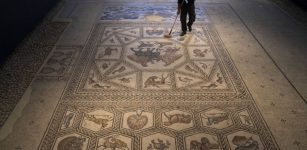 Exceptional 1,700-Year-Old Roman Mosaics Have Returned Home To Israel
Archaeology | Jun 27, 2022
Exceptional 1,700-Year-Old Roman Mosaics Have Returned Home To Israel
Archaeology | Jun 27, 2022 -
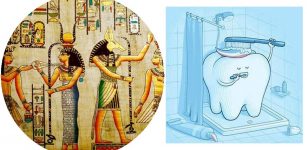 Ancient Egyptians Invented Toothpaste
Ancient Technology | Dec 26, 2015
Ancient Egyptians Invented Toothpaste
Ancient Technology | Dec 26, 2015 -
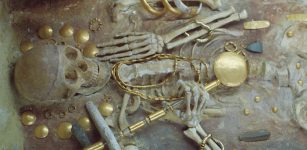 Archaeology Sheds Light On Why Some Ancient Societies Were More Unequal Than Others
Featured Stories | May 25, 2022
Archaeology Sheds Light On Why Some Ancient Societies Were More Unequal Than Others
Featured Stories | May 25, 2022




